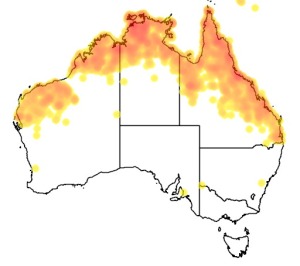Colours
Distinguishing features
Compared to the related Laughing Kookaburra, it is smaller, lacks a dark mask, has more blue in the wing, and striking white eye. It has a heavier bill than its larger relative. The head and underparts are cream-coloured with brownish streaks. It is sexually dimorphic, with a blue tail in the male, and a rufous tail with blackish bars in the female. Immature birds have more prominent brown bars and marks in their plumage, giving a 'dirty' appearance, and their eyes are predominantly brown for the first two years of life. (Wikipedia)
Size
- From 38 cm to 42 cm (Length of specimen)
Wingspan
- Wingspan data is not yet available.
Synonyms
Distribution
Distribution and habitat preferences
It has a distribution from southern New Guinea and the moister parts of northern Australia, to the vicinity of Brisbane in southern Queensland across the Top End, and as far down the Western Australian coast as the Shark Bay area. However, it does not occur between Broome and Port Hedland in northwestern Australia. (Wikipedia)
Diet
It hunts and eats a great variety of animals that live on or close to the ground. In the summer wet season, insects, lizards and frogs make up a higher proportion of their diet, while they eat arthropods such as crayfish, scorpions, spiders, fish, earthworms, small birds and rodents at other times. (Wikipedia)




